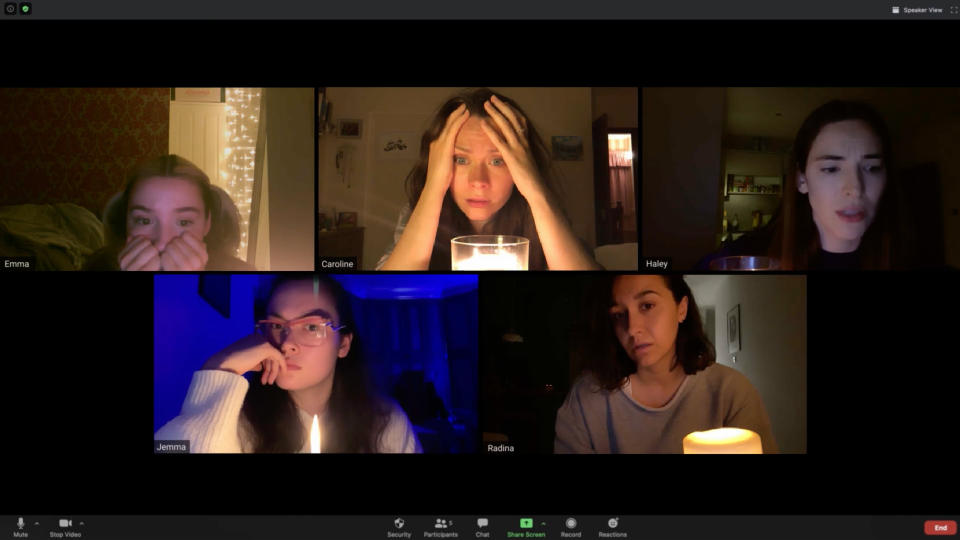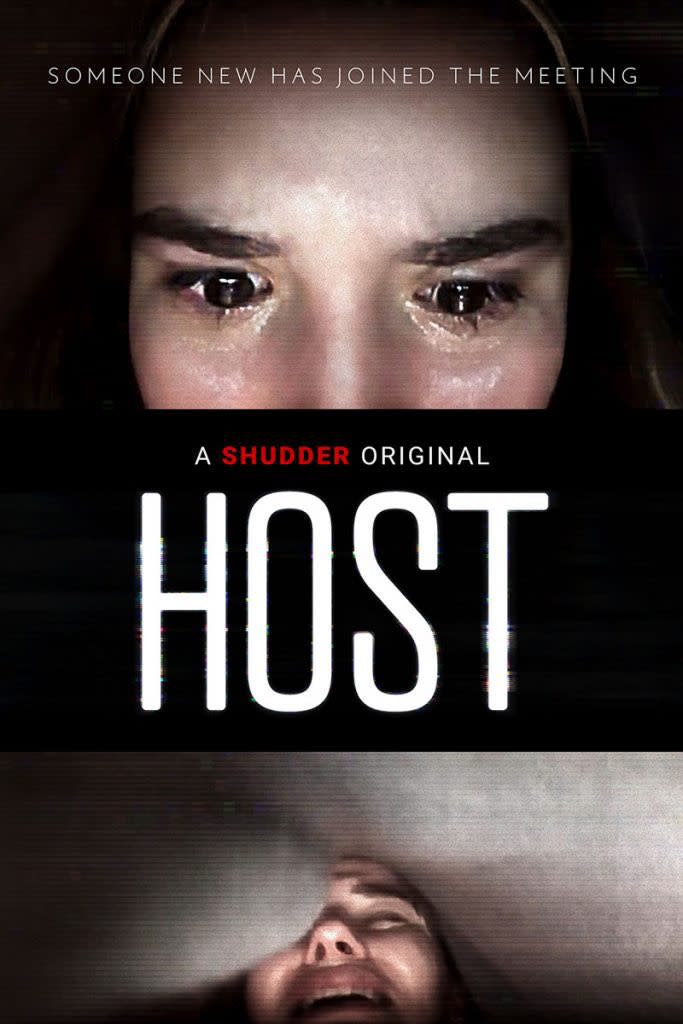How new horror film ‘Host’ was made on Zoom in lockdown

The film industry ground to a halt in March when coronavirus forced much of the world into lockdown. But while the rest of us were making banana bread, doing PE with Joe Wicks and watching Tiger King, writer-director Rob Savage – best known for horror short Dawn of the Deaf – was hard at work.
And what started out as a prank to scare his friends turned into Host, a genuinely terrifying flick that hits streaming service Shudder this week.
Host revolves around six friends who ask a medium to oversee a séance over Zoom. But what starts out as innocent fun quickly takes a sinister turn, with an evil spirit invading their homes and putting all their lives in danger.
As well as acting in the film, the cast did their own make-up, lit their own scenes, operated their own cameras, and created their own practical effects, while Rob directed them all from his own front room.
Here he explains how this unique production came together.
Host started with a joke
12 weeks ago we had an idea to make a movie during lockdown. Now #HOST is on the front page of @Shudder. Making a film with my friends has been such a gift during this mad time.
So turn off your lights, crank the volume and crack a beer. See you on the other side. #HappySpookies pic.twitter.com/neybTAB5Uf— Rob Savage (@DirRobSavage) July 30, 2020
Rob Savage: “It began as a prank video that I pulled on my friends where we were doing these daily ‘Happy Hours’ on Zoom. I told them I’d been hearing weird noises up in my attic, so I got them all on Zoom and I got them all to record while I went and investigated. Then I did a sneaky hidden transition within the Zoom call and played a clip from REC – the Spanish movie – where somebody goes up to the attic and a zombie jumps out at them.
Read more: Russell Crowe on returning to cinemas
“So for a moment they thought I’d been eaten by a zombie child. I cut that together and put that online and it ended up going a bit viral – it got millions of people watching it and enjoying it – and from there we thought that maybe this thing had legs.”
Host finds a home

“We pitched it to a bunch of places, and everyone jumped at it. There was a real bidding war because nothing else could really be made under lockdown conditions. So the pitch we went out with was basically us saying ‘It’s going to be really cool, we haven’t got any ideas yet, but just trust us.’ A lot of people jumped at that, strangely, and Shudder really got behind us even though we were figuring it out as we went along. When we pitched it to Shudder we didn’t even really have a concept beyond a bunch of friends doing a seance on Zoom and something scary happens.
Assembling cast and crew
“When we got to the writing stage me and the producers Douglas Cox and Jed Shepherd, who wrote it with me, and Gemma Hurley, who is the other writer, basically came up with a big list of what cool people we know who are currently sitting at home twiddling their thumbs with nothing to do. How can we work what they can do into our film?
“We knew some people who were isolating with riggers, and stunt co-ordinators, so we had these houses where everyone you need legally to perform these crazy stunts were isolating together. We had somebody who could do pyrotechnics and blow s*** up for us so we wrote that in. So it went from there. We did a Robert Rodriguez and looked at what we had access to and built the story from there.”
Principal photography

“We didn’t have a script – we worked off a 10-page treatment – so we started every day working with the actors and if something didn’t ring true we were able to change it and play around until we discovered what the film was going to be. It took about two weeks to shoot, and then we did the odd day here and there just to fine-tune and get bits of continuity fixed. But it was actually a relatively quick shoot for what it was.
“Because on a normal film set you spend most of your time sitting around while they set up the lights or you block the scene or fiddle with the camera. But when we were shooting, we’d have a 10-hour shooting day, and most of that time was spent actually shooting. So we got through a large amount of it every day, and were able to workshop it and improvise and refine as we went along.”
Keeping it real
New tee and mask arrived pic.twitter.com/pXxScMo2da
— Rob Savage (@DirRobSavage) July 12, 2020
“One of the things I was keen to do off the back of the prank video is withhold a lot of stuff from the cast. We knew how everyone was going to die, and we knew what the scares were going to be, and we didn’t tell the actors any of it. So the first thing we shot was all the stunts and all the scares. We cut those together and we added in sound effects and made them properly scary. Then like we did on the prank video, when we were shooting on the day, I was able to cede that into Zoom and get the guys to react in real time, not knowing what was going to happen. So a lot of the reactions you are getting in the film are them genuinely reacting to their friends dying in front of them or something jumping out or exploding. Which I think is why a lot of it feels so authentic.”
Crafting the visual effects
“I’ve worked with [Special Effects Make-Up Designer] Dan Martin a bunch of times and he’s one of the people we had on our initial list of cool people. So without ruining too much, there’s a scene where somebody’s face takes on a bit of damage, and we knew that Zoom was a pretty unforgiving medium in terms of it just being the actor’s face in close-up, so we needed Dan to help us with some designs and effects that were going to stand up to that scrutiny.
Read more: The best horror films of 2019
“So we got Dan to create little latex pieces and then he did a video tutorial for our actress and then he was there on Zoom while she was applying it. So she was being the make-up team – doing it on herself – with Dan co-ordinating. I think she did a pretty great job with it, and Dan was great, being very specific with what he needed her to do.”
Challenges and problems
“Because we were basically asking every single actor to be a one-person film production, it was the technical stuff that happens behind the scenes – that nobody really thinks about because it happens invisibly on a film set – that caused problems. For instance with Teddy [Linard], his house is out in the middle of nowhere in the countryside, and when we cast him by Zoom, we’d get a freeze-frame, and then five seconds later another freeze-frame. His internet was so bad that we wouldn’t have been able to see what he was doing.
“So we had to send out some special equipment to boost the signal. And once he’d shot his footage we had to figure out how he’d get it to us. Do we have to courier everything over? Are the courier services even running as this was mid-lockdown? So all the logistics once we’d actually shot the stuff – how do we get a bunch of actors who don’t know anything about standardising and logging all the footage to do that? Then how do we get that to an editor who can actually make sense of it? Especially as we were shooting hours and hours of the stuff.”
Going with the flow
“It was really nice figuring it out as we went along. I’m a bit of a control freak, so that was the thing I was most stressed about, but the thing I ended up enjoying the most was the fact that I wasn’t able to be hands-on. I had to use my words rather than running in and doing things myself. And also not having a script. Normally when you’re doing a TV production you’ve got seven pages that you need to shoot and you’ve got to be out by a certain time and there’s all this money riding on it. Here it was a low-budget thing, I was doing it with my friends, we were figuring it out as we went along. We all just felt very present and in the moment, and some of my favourite stuff was the stuff we came up with on the day rather than the planned stuff.”
Sequel plans
“I’m dying to [shoot another]. I think there’s so much you can do. I’m a big ‘found footage’ fan, and as long as it’s done well, I think it can be really effective. Who knows when the world is going to be fully back to normal? But what I’m most excited about if we do another is on one hand you’re limited because of how you have to make the film, but on the other, because you’re making it all remotely, you can access anyone. If there was a very specific stunt you needed doing, we could get somebody on the other side of the world to do it and film if for us, as long as they had an internet connection. Now we’ve ironed out all the kinks, I think we could do something as a follow-up that’s even bigger and more surprising than this one.”
“I think a laptop is probably [the best way to watch Host]. We decided very early on to keep all the Zoom graphics onscreen the whole time so if you are watching on a laptop part of you would forget and think that you are a silent member of this Zoom call. So it’s very much designed for watching on a laptop. But any way you want to watch it. I think it would be fun to watch with friends, or on your own in a dark room. Just make sure you crank the sound up and turn the lights down!”
Host is streaming on Shudder now.

 Yahoo Finance
Yahoo Finance 